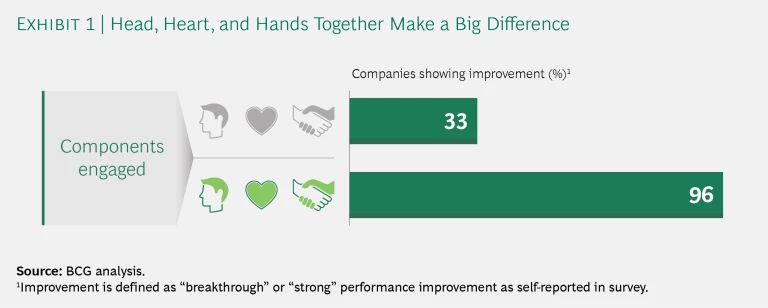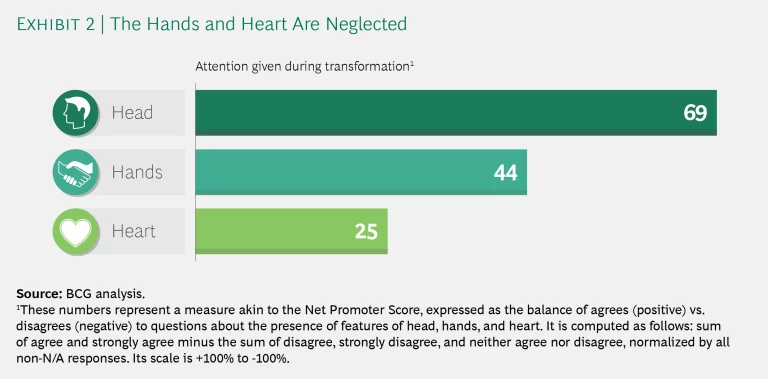It is rare these days, as digital transformation sweeps the business landscape, to meet a business leader who hasn’t either recently led or been part of a transformation. Once a one-off event in response to an urgent need—a dire competitive threat, sagging performance, an overdue process overhaul, or a post-merger integration—transformation is now the new normal. In fact, it has become so commonplace that we have dubbed this the era of “always-on” transformation.
Yet from experience we know that transformation continues to be very difficult, and the evidence shows that it often fails or falls short of expectations. Moreover, it can exact an enormous toll on leaders and employees, who are constantly being asked to step up, reach further, move faster, and adapt to change, with no end in sight. For leaders and employees alike, it’s less a marathon and more a triathlon; no sooner does one leg finish than another is under way, giving participants no chance to catch their breath before giving their all once again. Still, many organizations overcome the odds; some even achieve lasting results. How do these companies succeed where others fail?
A Reimagined Approach to Transformation
While there is no one-size-fits-all method, our extensive client work, along with our study of more than 100 companies that have undergone transformations (three or more for 85% of them), points to an approach that combines three interconnected elements. It involves thinking expansively and creatively about the future that the organization aspires to and focusing on the right strategic priorities to get there. It addresses the unrelenting, ever-shifting, ever-growing demands on employees by elevating the importance of actions that will inspire and empower people at all levels of the organization. And at a time of rapid change and disruption, it calls for more than just applying the appropriate means and tools to execute; it calls for companies to innovate while they execute—and do both with agility.
In other words, transformation in the new digital era requires a holistic, human-centric approach, one we call the Head, Heart, and Hands of Transformation. The heart has received the least consideration, but it is attention to all three elements that enables organizations to succeed today and thrive tomorrow.
Transformation in the new digital era requires a holistic, human-centric approach.
Three Challenges in the Always-On Era
Transformation today takes place from a variety of starting positions. Some organizations need to move quickly to improve the bottom line. Others enjoy respectable performance but lack a clear path to enduring success. Many companies are simply in need of rejuvenation, ready to imagine a new destiny and perhaps even to increase their contribution to society.
Transforming not merely to survive but to thrive entails addressing three broad challenges, crystallized in these questions:
- How do we create our vision for the future and identify the priorities to get there? Many companies face an even bigger challenge than overcoming short-term performance pressures: How to reconcile multiple strategic options to envision a different future amid shifting customer needs, evolving technologies, and increasing competition.
- How do we inspire and empower people? The relentless pace of always-on transformation can demoralize even the most engaged employees. Sustaining it while offering employees meaningful opportunity and fulfillment—intrinsic rewards that millennials and “digital natives” seek—adds substantial complexity to the challenge.
- How do we execute amid constant change? Changing the business once meant executing from a playbook of primarily short-term, discrete actions. But transforming to thrive in the future often requires disrupting existing business models and value chains to solve customer needs—and doing so at digital speed. Today, when changing the business means simultaneously executing and innovating with agility, a conventional approach to execution is no longer enough.
Taken together, these three challenges can seem overwhelming. But they need not be.
Consider Microsoft. In February 2014, when Satya Nadella took the helm, the company was by no means broken, yet there were strong headwinds: Windows’ market share had declined, Microsoft had missed the mobile wave, and competitors—and customers—were moving aggressively to the cloud. The company’s inhospitable culture was depicted in a now-famous meme showing managers in different corners of the organization chart shooting guns at one another.
Since then, Microsoft’s performance hasn’t just improved; it has flourished. Revenues (particularly cloud-based revenues) have soared, the company’s stock price has more than tripled, market capitalization is approaching $1 trillion, and annualized TSR, at 26.5%, is twice that of the S&P 500. Perhaps most important, the company now boasts a visibly new culture of cooperation and a renewed commitment to innovation.
Microsoft’s wholesale transformation has been the result not of a single move but of many changes orchestrated in parallel that have touched every part of the organization. Nadella honed a mobile-first, cloud-first vision, aligning leaders around it and shifting resources toward the relevant businesses to accelerate innovation. In other words, he addressed the head of transformation. He articulated a new purpose—“to empower every person and organization on the planet to achieve more”—and fostered a new culture and leadership model, thus tending to the heart of transformation. He also unleashed new ways of working that have not only enabled execution but also have spurred innovation and agility; that is, he equipped the hands of transformation.
Microsoft’s wholesale transformation has been the result not of a single move but of many changes orchestrated in parallel.
Microsoft’s transformation has reinvigorated a maturing company, positioning it to define and embrace its future with the strength and agility needed to thrive in a fast-changing, tumultuous business landscape.
The Power of Head, Heart, and Hands
What actions constitute this fresh take on transformation? And what sets it apart from more traditional approaches?
- The Head: Envision the future and focus on the big rocks. In the digital era, constant change makes it harder to commit to a view of the future; yet providing direction to the organization remains essential. That means companies and their leaders must draw on their strategic thinking, their imagination, their knowledge of customer needs and desires, and their pool of expertise, experience, and wisdom to forge an aspirational vision of a digitally enabled, growth-oriented future. They set priorities, focusing on the “big rocks” that will deliver results and create enduring value.
1 1 “Big rocks” is a reference to Stephen Covey’s famous demonstration of setting priorities: filling a large mason jar with rocks (the most important things), then gravel, then sand, and finally water (items of lesser importance that can be fit in). They secure the alignment and commitment of the leadership team. And they establish and communicate a compelling case for change, internally and externally. In the past, these actions might have been one-and-done moves, distinct from the daily rhythms of business. But today, because the environment is constantly shifting and these strategic actions generally affect the whole enterprise, they must be revisited and updated on an ongoing basis (ideally, annually) and be integrated into the operating model of the organization. - The Heart: Inspire and empower your people. When transformations were viewed as one-off, short-term programs, inspiring and empowering people wasn’t seen as being essential to them; in fact, people were often treated as a means to an end or, worse, as collateral damage. But successful transformation today depends on people who are engaged and motivated to go above and beyond. Organizations can create this condition through a set of heart “practices.” What does this mean? Leaders invest time and energy in articulating, activating, and embedding the organization’s purpose. Companies create an empowering culture, shaped by leaders, that allows people to do their best work. They also demonstrate care for those whose lives are disrupted by the change—not only departing employees but those who remain to carry out the new vision. Finally, senior managers exercise a more holistic form of leadership: they clarify and navigate, they include and empower, and they delegate and enable their people and teams.
- The Hands: Execute and innovate with agility. Executing a prescribed set of actions used to be enough to generate short-term bottom-line improvements. In this new era, when the future is unclear and the present is constantly changing, organizations need to innovate as they execute, and do both with agility. Consider this: Rather than delegate responsibility for execution to a transformation program owner (who occasionally updates leaders), companies give joint ownership of the ongoing transformation agenda to senior leaders. They ensure disciplined execution by equipping teams with the resources they need to make sound, prompt decisions. Companies also apply innovative methods and digital tools, and institute agile ways of working, to accelerate output, remove impediments, and enable end-to-end focus on the customer. Whereas building organizational capabilities was often an afterthought, today companies build capabilities while carrying out the transformation.
The head, heart, and hands approach to transformation is most powerful when each element is fully deployed. For this reason, the three elements should not be viewed as sequential actions but as three vital sets of activities that should happen in parallel—a holistic system.
Evidence of the impact of this approach is striking. In our study, which included in-depth interviews of leaders involved in these efforts, we asked whether the companies had addressed the actions consistent with the three elements. We then correlated the response with their subsequent performance. Ninety-six percent of the companies that fully engaged the three elements achieved sustained performance improvement, a rate nearly three times that of companies that did not engage the elements. (See Exhibit 1.)
When we asked survey respondents about the relative attention given to each of the three elements during transformation, the head consistently got the highest rating, followed by the hands. The heart came last. (See Exhibit 2.)
It’s thus only fitting that the heart—as the metaphorical center and source of inspiration and power—is at the center of this holistic approach.
The Heart of Transformation: Inspire and Empower Your People
People—individuals and teams—are the lifeblood of successful transformation. Transformation requires their effort, engagement, alignment, and willingness to go the extra mile. But in practice, the importance of people in transformation is often neglected; people often end up being treated as expedient or even dispensable. In the always-on era, the consequences of this neglect can be great, as people grow exhausted from keeping up with the latest technologies and adapting to relentless change.
Successful transformation takes heart. The heart serves as an apt metaphor, capturing the essence of the vital, life-giving source of power that people need to effect change.
So how can organizations develop a strong, healthy heart to inspire and empower people? In the context of transformation, we see four imperatives. Each of them, like the atria and ventricles of the heart, works in concert to perform the heart’s complete job: empowering and enabling people to give life to the transformation. (See “Healthy Heart, Strong Performance.”)
Healthy Heart, Strong Performance
Healthy Heart, Strong Performance
The heart’s impact on transformation results is measurable—and compelling. In our survey, we derived “heart scores” for the companies based on their responses to a battery of questions about the characteristics and impact of their transformations. Among the companies that experienced strong sustained performance, the proportion with high heart scores was more than double the proportion of those with low heart scores. Moreover, a substantial proportion of low scorers performed more poorly at the end of the transformation than at its start. (See the exhibit.)
Activate and Embed Purpose
Increasingly, employees seek much more than a paycheck or tangible rewards; they want meaning, connection, and joy. They want to contribute, develop, and achieve. Organizations with purpose tap into these needs, producing a virtuous circle of benefits.
Purpose is an organization’s “why”—its existential reason for being. In the always-on era, it is more important than ever; it fuels transformation by fostering an emotional connection that inspires greater commitment and the willingness to go the extra mile. Purpose illuminates a direction as it links various transformation efforts in a way that is logical and accessible to everyone. But it can do so only when the organization translates it effectively into action.
In the always-on era, purpose is more important than ever.
Create an Empowering Culture
Culture is the lifeblood of the organization. It comprises a clear articulation of the values and behaviors that define how things get done in an organization. Activated by leaders, culture is reinforced by the organizational environment, or context, through such levers as customer service rituals, performance management systems, and informal interactions. A healthy culture serves as a tacit code of conduct that steers individuals to make choices that advance the organization’s goals and strategy. In the digital era, when self-direction and team autonomy are emphasized, a strong culture is particularly important.
Demonstrate Care
Layoffs, redeployments, and reskilling are inevitable today. Even healthy companies will likely have to restructure their workforce to add talent—in particular, people with digital skills and experience that align more closely with the business’s future needs. Such workforce turbulence can be traumatic not only for those who are laid off but also for those who remain. If left unattended, it can undermine morale and progress. At the very least, transformation can dampen engagement and disrupt employee cohesion, and it almost always puts extra demands on people.
For all these reasons, leaders must demonstrate care, compassion, and empathy—and not just through their words. For example, it is critical that leaders continue to solicit the input of employees who remain (say, through pulse checks or broader two-way communications) and actively, visibly address their concerns. To help employees who are leaving, companies can offer a battery of program options beyond the standard outplacement services, such as coaches to help individuals create a personal roadmap, job-market information sessions, resources for financial advice, and even guidance on entrepreneurship.
Lead with the Head, Heart, and Hands
Nothing is more important to the success of transformation than leaders. While they play many roles, leaders embody the heart of transformation.
Leaders clarify and navigate the way forward. Beyond envisioning the future and revisiting strategic priorities regularly, leaders provide constant guidance to their reports and unit heads and ensure that priorities remain linked to purpose. They are action oriented; they set clear accountabilities; and they work tirelessly to communicate a compelling case for change internally and externally.
Leaders are inspiring, empowering, and inclusive. Leaders instill confidence and courage, and motivate and inspire people to perform. They strengthen and encourage teams and support cross-organization collaboration. They demonstrate care and empathy, actively and candidly communicate with their people, and exercise inclusiveness.
Leaders delegate and enable agile teams. Leaders delegate responsibilities to autonomous agile teams, remove obstacles, and ensure all the necessary cross-functional resources are in place. They also support capabilities building, both human and digital.
Embracing the Head, Heart, and Hands of Transformation
In the digital era, transformation has become the default state for most organizations. But always-on transformation needn’t be debilitating, exhausting, or demoralizing. We owe it to ourselves, our organizations, and society itself to boldly transform the approach we take to transformation.
Leaders need to move beyond short-term fixes to envision a compelling future, and focus on the big rocks required to get there. They need to stop treating people as a means to an end or, worse, as collateral damage, and instead inspire and empower them. They need to change how work gets done, moving from the expedient and prescribed set of actions to an approach that enables execution and innovation to occur simultaneously, with agility.
The head, heart, and hands of transformation is not a panacea, but it is a holistic and human-centric approach that is proven to enable organizations that truly embrace it to succeed today and thrive tomorrow.








